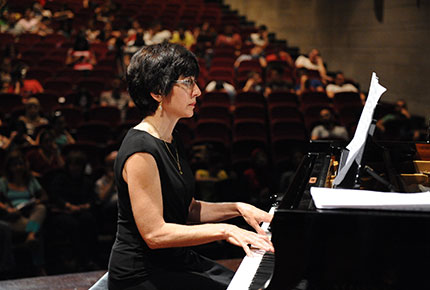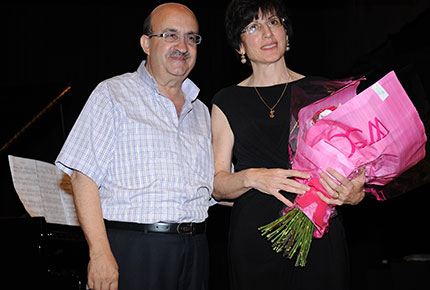Apollo Syndrome: the musician-physician connection
The Greek deity Apollo was the god of both music and medicine; LAU’s Dr. Nancy Chedid explores the relationship between the two disciplines.
The relationship between a musician and a physician is not one that is well known nor often contemplated. Yet in an exploratory lecture Dr. Nancy Chedid, faculty member at LAU’s Gilbert and Rose-Marie Chagoury School of Medicine, spoke of the bonds that bring them together, and often. The lecture, one of a series organized by composer Joseph Khalife, the university’s musician-in-residence, linking music to different disciplines that took place at the Selina Korban Theater at LAU Byblos last week.
“I wanted to prove to students that music is the essence of life and an ongoing process that accompanies all that you do,” Khalife explains.
Chedid, who earned her B.A. in Music in 1980 followed by an M.D. four years later, drew on her personal discoveries, as well as her observations of the crowd she hung around with at the time. She noticed that there were consistent physical traits in both musicians and physicians. Expanding on these personal observations, Chedid conversed animatedly about the unfamiliar musician-physician connection.
For Chedid the healing and soothing powers of music were recognized long ago. “Music hath charms to soothe a savage breast, to soften rocks or bend a knotted oak,” she points out quoting the 17th century writer, William Congreve. She also pointed to the recent therapeutic methods in treating patients suffering from aphasia – the impaired ability to speak – explaining that patients, who are not able to speak, could actually sing. Singing could therefore lead to a rehabilitation of speech.
It was upon joining the Boston Symphony doctoral orchestra that Chedid discovered an unusual phenomenon. Fritz Kreisler, Alexander Borodin, Theodor Billroth, Albert Schweitzer, Herman Beorhaave, Hector Berlioz, Herman von Helmholtz, Johannes Brahms, to name a few classical musicians, were all physicians as well.
To develop on the link between musicians and physicians, Chedid traced their path from the Greek mythology to classical musicians ending with contemporary literature. Scales to Scalpels, a recent publication, coined the consistency in traits in musicians and physicians. “The wiring of musicians and physicians brains are similar,” explains Chedid. “They display a high level of alertness. Their calmness is accompanied by readiness for action. They show an interest in learning. They demonstrate the ability to see the “big picture”. They are efficient in the use of brain resources. They also express remarkable levels of moral reasoning.”
For Khalife, music is an integral part of a person’s life. “It starts with the heartbeat in your mother’s womb. It’s a regular rhythm that’s part of you and when this beat stops it means death. Music is an essential part of mankind and all sciences have a link of some sort to music. Pythagoras was a doctor, an engineer and a musician at the same time,” he stresses as Chedid ended her lecture with a beautifully performed four-minute “intermezzo in A major” by Johannes Brahms.
More
Latest Stories
- Student Pharmacists: Serving Through Uncertainty
- Research Highlight: Dr. Elie Bouri on Cryptocurrency
- The Threat of Gram-Negative Bacteremia on Public Health in Lebanon
- A Frontline Like No Other: Students Take Action
- Fostering Healthy Connections in Times of Conflict
- The Crucial Role of Anesthesiologists in Mass Casualty Response
- Another Groundbreaking Discovery by the LAU Genetics Team
- LAU Faculty Recognized Regionally for Teaching Innovation



